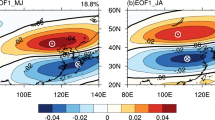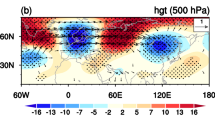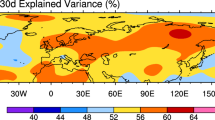Abstract
Based on observational and reanalysis datasets, this study investigates the structure and dynamics of a wave-like atmospheric teleconnection pattern along the wintertime Asian jet and its influence on East Asian climate. Along the jet, the leading empirical orthogonal function (EOF) mode of monthly meridional winds at 250-hPa in winter (December, January, and February) is organized as a wave train with maximum anomalies at upper troposphere. The wave train propagates northeastward from the North Atlantic to Europe, turns southeastward to the Middle East with amplifying amplitude, propagates along the jet to South China, and reaches Japan, which is partly induced by sea surface temperature (SST) anomalies in the equatorial eastern Pacific and the North Atlantic Oscillation. Over the sector from Europe to the Middle East, the anomalous vortices in the wave train tilt northwestward with height and tilt northeast/southwest in horizontal at 250 hPa, favoring for extracting available potential energy and kinetic energy from mean flows effectively. In addition, there exists a positive feedback between transient eddies and the wave train-related anomalous circulation over the North Atlantic and Europe. These processes help to maintain and amplify the wave train. Moreover, the wave train can exert significant influences on the wintertime climate in East Asia. When it is in the phase with a cyclone (anticyclone) over South China (Japan), rainfall tends to be above normal in South and East China and surface air temperature tends to be above normal around Japan and the Korea peninsula.













Similar content being viewed by others
References
Adler RF et al (2003) The version-2 global precipitation climatology project (GPCP) monthly precipitation analysis (1979–Present). J Hydrometeorol 4:1147–1167
Branstator G (2002) Circumglobal teleconnections, the jet stream waveguide, and the North Atlantic Oscillation. J Clim 15:1893–1910
Chen G, Huang R (2012) Excitation mechanisms of the teleconnection patterns affecting the July precipitation in Northwest China. J Clim 25:7834–7851
Ding Q, Wang B (2005) Circumglobal teleconnection in the Northern Hemisphere Summer*. J Clim 18:3483–3505
Enomoto T, Hoskins BJ, Matsuda Y (2003) The formation mechanism of the Bonin high in August. Q J Roy Meteor Soc 129:157–178
Gill AE (1980) Some simple solutions for heat-induced tropical cirulation. Q J Roy Meteor Soc 106:447–462
Hoskins BJ, Ambrizzi T (1993) Rossby wave propagation on a realistic longitudinally varying flow. J Atmos Sci 50:1661–1671
Hoskins BJ, James IN, White GH (1983) The shape, propagation and mean-flow interaction of large-scale weather systems. J Atmos Sci 40:1595–1612
Huang G, Liu Y, Huang R (2011) The interannual variability of summer rainfall in the arid and semiarid regions of Northern China and its association with the northern hemisphere circumglobal teleconnection. Adv Atmos Sci 28:257–268
Kanamitsu M, Ebisuzaki W, Woollen J, Yang SK, Hnilo J, Fiorino M, Potter G (2002) Ncep-doe amip-ii reanalysis (r-2). B Am Meteorol Soc 83:1631–1644
Kosaka Y, Nakamura H (2006) Structure and dynamics of the summertime Pacific–Japan teleconnection pattern. Q J Roy Meteor Soc 132:2009–2030
Kosaka Y, Nakamura H, Watanabe M, Kinoto M (2009) Analysis on the dynamics of a wave-like teleconnection pattern along the summertime Asian jet based on a reanalysis dataset and climate model simulations. J Meteorol Soc Jpn 87:561–580
Lau N-C, Nath MJ (2014) Model simulation and projection of European heat waves in present-day and future climates. J Clim 27:3713–3730
Li Y, Lau N (2012) Impact of ENSO on the atmospheric variability over the North Atlantic in late winter—role of transient eddies. J Clim 25:320–342
Li C, Sun J (2015) Role of the subtropical westerly jet waveguide in a southern China heavy rainstorm in December 2013. Adv Atmos Sci 32:601–612
Li X, Zhou W (2016) Modulation of the interannual variation of the India-Burma Trough on the winter moisture supply over Southwest China. Clim Dyn 46:147–158
Lin H, Derome J, Brunet G (2005) Tropical Pacific link to the two dominant patterns of atmospheric variability. Geophys Res Lett 32:L03801. doi:10.1029/2004GL021495
Liu Y, Wang L, Zhou W, Chen W (2014) Three Eurasian teleconnection patterns: spatial structures, temporal variability, and associated winter climate anomalies. Clim Dyn 42:2817–2839
Lu R, Oh J, Kim B (2002) A teleconnection pattern in upper-level meridional wind over the North African and Eurasian continent in summer. Tellus A 54:44–55
Matsuno T (1966) Quasi-geostrophic motions in the equatorial area*. J Meteorol Soc Jpn 44:25–43
Metz W (1991) Optimal relationship of large-scale flow patterns and the barotropic feedback due to high-frequency eddies. J Atmos Sci 48:1141–1159
North GR, Bell TL, Cahalan RF, Moeng FJ (1982) Sampling errors in the estimation of empirical orthogonal functions. Mon Weather Rev 110:699–706. doi:10.1175/1520-0493(1982)110<0699:SEITEO>2.0.CO;2
Sardeshmukh PD, Hoskins BJ (1988) The Generation of global rotational flow by steady idealized tropical divergence. J Atmos Sci 45:1228–1251
Sato N, Takahashi M (2006) Dynamical processes related to the appearance of quasi-stationary waves on the subtropical jet in the midsummer Northern Hemisphere. J Clim 19:1531–1544
Song J, Li C, Zhou W (2013) High and low latitude types of the downstream influences of the North Atlantic Oscillation. Clim Dyn 42:1097–1111
Song L, Wang L, Chen W, Zhang Y (2016) Intraseasonal variation of the strength of the East Asian trough and its climatic impacts in boreal winter. J Clim 29:2557–2577
Takaya K, Nakamura H (2001) A formulation of a phase-independent wave-activity flux for stationary and migratory quasigeostrophic eddies on a zonally varying basic flow. J Atmos Sci 58:608–627
Wang L, Chen W (2010) How well do existing indices measure the strength of the East Asian winter monsoon? Adv Atmos Sci 27:855–870
Wang L, Chen W (2014) An intensity index for the East Asian winter monsoon. J Clim 27:2361–2374
Wang L, Feng J (2011) Two major modes of the Wintertime Precipitation over China. Chin J Atmos Sci 35:1105–1116
Watanabe M (2004) Asian jet waveguide and a downstream extension of the North Atlantic oscillation. J Clim 17:4674–4691. doi:10.1175/JCLI-3228.1
Yanai M, Esbensen S, Chu JH (1973) Determination of bulk properties of tropical cloud clusters from large-scale heat and moisture budgets. J Atmos Sci 30:611–627
Yu B, Lin H (2016) Tropical atmospheric forcing of the wintertime North Atlantic oscillation. J Clim 29:1755–1772
Zhou LT, Wu R (2010) Respective impacts of East Asian winter monsoon and ENSO on winter rainfall in China. J Geophys Res 115:D02107
Acknowledgements
We thank two anonymous reviewers for their helpful comments. This work was supported by the National Natural Science Foundation of China (41425019, 41661144016, 41275081 and 41205049) and the public science and technology research funds projects of ocean (201505013).
Author information
Authors and Affiliations
Corresponding author
Additional information
This paper is a contribution to the special issue on East Asian Climate under Global Warming: Understanding and Projection, consisting of papers from the East Asian Climate (EAC) community and the 13th EAC International Workshop in Beijing, China on 24–25 March 2016, and coordinated by Jianping Li, Huang-Hsiung Hsu, Wei-Chyung Wang, Kyung-Ja Ha, Tim Li, and Akio Kitoh.
Rights and permissions
About this article
Cite this article
Hu, K., Huang, G., Wu, R. et al. Structure and dynamics of a wave train along the wintertime Asian jet and its impact on East Asian climate. Clim Dyn 51, 4123–4137 (2018). https://doi.org/10.1007/s00382-017-3674-1
Received:
Accepted:
Published:
Issue Date:
DOI: https://doi.org/10.1007/s00382-017-3674-1




